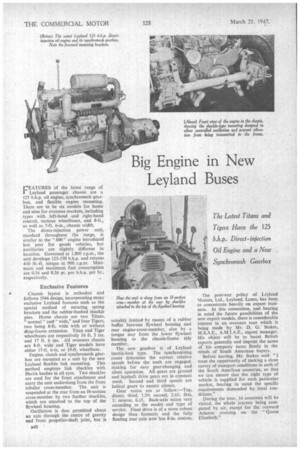Big Engine in New Leyland Buses
Page 46

If you've noticed an error in this article please click here to report it so we can fix it.
FEATURES of the latest range of Leyland passenger chassis are a 125 b.h.p. oil engine, synchromesh gearbox, and flexible engine mounting. There are to be six models for home and nine for overseas markets, including types with left-hand and right-hand control, various wheelbases, and 8-ft., as well as 7-ft. 6-in., chassis width.
The direct-injection power unit, standard throughout the range, is similar to the " 600 " engine introduced last year for goods vehicles, but auxiliaries are slightly different in location. Governed at 1,800 r.p.m., the unit develops 125-130 b.h.p. and returns 410 lb.-ft. torque at 900 r.p.m. Minimum and maximum fuel consumption are 0.34 and 0.36 pt. per b.h.p. per hr., respectively.
Exclusive Features
Chassis layout is orthodox and follows 1946 design, incorporating many exclusive Leyland features such as the special method of securing spring brackets and the rubber-bushed shackle pins. Home chassis are two Titans, "normal " and wide," and four Tigers, two being 8-ft. wide with or' without drop-frame extension. Titan and Tiger wheelbases are respectively 16 ft. 3 ins. and 17 ft. 6 ins. All overseas chassis are 8-ft. wide and Tiger models have either 17-ft. 6-in. or 19-ft. wheelbase.
Engine, clutch and synchromesh gearbox are mounted as a unit by the new Leyland flexible link mounting. This method employs link shackles with Harris bushes in all eyes. Two shackles are used for the front attachment and carry the unit underslung from the front tubular cross-member. The unit is suspended at the rear from an H-section cross-member by two further shackles, which are attached to the top of the flywheel housing.
Oscillation is thus permitted about an axis through the centre of gravity and front propeller-shaft joint, but is
B40 ' suitably limited by means of a rubber buffer between flywheel housing and rear engine-cross-member, also by a torque stay from the lower flywheel housing to the chassis-frame sidc member.
The new gearbox is of Leyland inertia-lock type. The synchronizing cones determine the correct relative speeds before the teeth are engaged, making for easy gear-changing and silent operation. All gears are ground and layshaft drive gears are in constant mesh. Second and third speeds are helical gears to ensure silence.
Gear ratios are as follow:—Top, direct; third, 1.59; second, 2.63; first, 5; reverse, 6.15. Back-axle ratios vary according to the model and type of service. Final drive is of a more robust design than formerly and the fully floating rear axle now has 8-in. centres. The post-war policy of Leyland Motors, Ltd., Leyland, Lanes, has been to concentrate heavily on export business. In this connection, and bearing in mind the future possibilities of the new export models, there is considerable interest in an overseas tour which is being made by Mr. D. G. Stokes, M.S.A.E., export manager. His object will be to boost British exports generally and imprint the name of his company more firmly in the minds of South American buyers.
Before leaving, Mr. Stokes said: "I want the opportunity of making a close survey of transport conditions in each of the South Amefican countries, so that we can ensure that the right type of vehicle is supplied for each particular market, bearing in mind the specific requirements demanded by local conditions."
During the tour, 14 countries will be visited, the whole journey being completed by air, except for the outward Atlantic crossing on the -" Queen Elizabeth."












































































